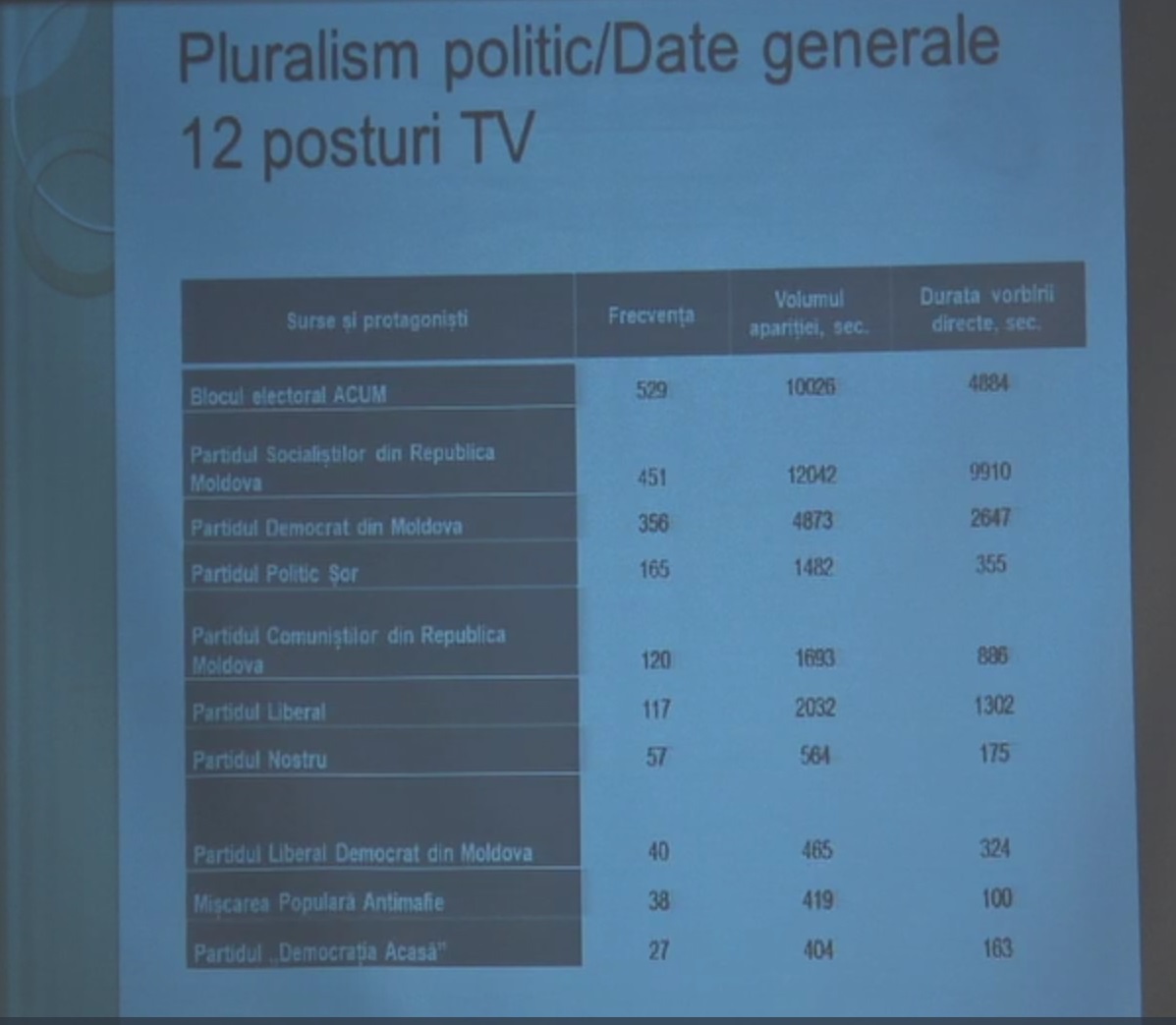
The total of 28 media outlets were analysed, of which 12 TV broadcasters and 16 news portals and newspapers. The IJC Executive Director, Nadine Gogu, explained that the monitoring also covered the pre-election period to see what are the trends and phenomena in the media. According to her, the basic methodology focuses on quantitative and qualitative analysis.
The report assesses social and political pluralism in the media, which implies measurement of the diversity of opinions and plurality of voices in election materials. For instance, the evaluators found out that the following election candidates for the national constituency were the most visible political actors from the point of view of political pluralism in the broadcasting: ACUM Electoral Bloc, PSRM, PDM, ‘Sor’ Party and PCRM. Among candidates who entered the electoral race in single-member constituencies, the most widely covered ones were Andrei Nastase, Vladimir Plahotniuc, Ilan Sor, Zinaida Greceanii and Pavel Filip.
The tone of coverage was largely neutral for most election candidates and political actors at the Moldova 1 public TV channel, except for the Cabinet of Ministers that enjoyed a more positive tone. The GRT was passive during the reporting period, while private TV channels with nationwide coverage – Prime TV, Canal 2, Canal 3 and Publika TV, were covering mainly the events with the participation of various power holders from the Democratic Party. Jurnal TV has allocated more airtime for the members of the ACUM Election Bloc and Andrei Nastase, the tone of coverage being predominantly neutral and positive. NTV Moldova and Accent TV gave the most broadcast time both to the representatives of PSRM (the candidate in the national constituency), and to the election candidates in the single-member constituencies affiliated with this party, as well as to the President Igor Dodon, using rather positive and neutral tone. The Central Television has allocated more airtime for the ‘Sor’ Political Party, also being neutral and positive. TV8 and Pro TV Chisinau TV channels granted access to a wide range of political actors – parties, election candidates in the nationwide and single-member constituencies, representatives of the Presidency, the Parliament and the Government, ensuring balance between the duration of direct appearances and statements.
‘Some of the media outlets that were featured in our report as using positive or neutral tone in regard to certain election candidates will certainly have different results later. However, there will also be broadcasters and printed and online press outlets that will proceed with the same editorial policy. That is why we not only launching our report at a press conference, but we will also send it to the Broadcasting Council and to the monitored media outlets, hoping they will read it carefully and learn about their issues (if any) and act in accordance with the Code of Ethics, not to mention the Broadcasting and Electoral Codes’, said Nadine Gogu, the Executive Director of IJC.
The monitored portals and newspapers predominantly covered the political activity, including declarations, accusations and statements of potential election candidates and those registered in the national constituency and in some single-member constituencies (772 materials); the electoral process itself, meaning the activity of CEC and certain constituency councils, was widely covered as well (240). In the electoral context, certain social subjects (69), situation/issues of the Moldovan diaspora (51), state of economy (47) and others also were covered.
After analysing the report on online and printed press, the Executive Director of API Petru Macovei identified two trends and namely – authors’ value judgements and lack of political pluralism. ‘Newscasts do not contain any value judgements. We can find them on separate pages, editorial and opinion columns. Unfortunately, our media outlets, including the websites monitored under this project, are nothing but the mouthpieces of parties they sympathize with and actively promote. The second important thing to understand is that media outlets must cover the election campaign in a balanced way and offer space to all or most of the candidates. We see certain selective manipulations (at least in online and printed press) meaning that only those events that were organised by a certain election candidate are covered, while others are overlooked’, says Macovei.
The media outlets were selected on the basis of the following criteria: a) ownership; b) geography; c) broadcast language; d) popularity/audience. Thus, public and private media outlets, those with nationwide, quasi-nationwide and regional coverage, and those in Romanian and Russian are subject to monitoring. The following media outlets were monitored in terms of broadcasting: Moldova 1, GRT, Prime TV, Canal 2, Canal 3, Publika TV, Jurnal TV, NTV Moldova, Pro TV Chisinau, TV8, Accent TV, Central TV; online portals and printed press – agora.md, Aif.md, Deschide.md, Diez.md, Esp.md, Gagauzinfo.md, Jurnal de Chisinau (newspaper), Kp.md, Moldova.org, Newsmaker.md, Noi.md, Realitatea.md, Sputnik.md, Timpul.md, Unimedia.info, Zdg.md.










